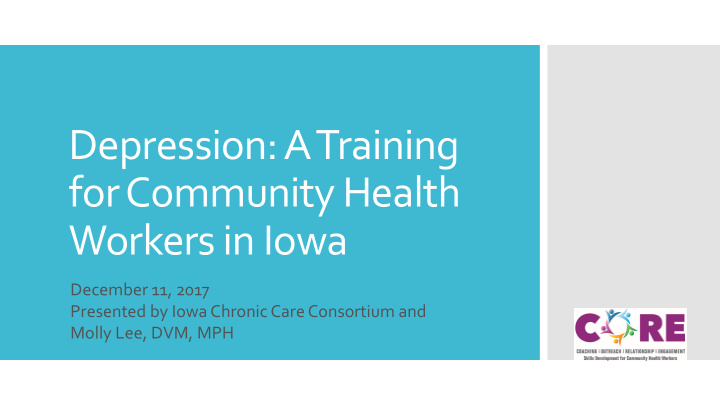



Depression: A Training for Community Health Workers in Iowa December 11, 2017 Presented by Iowa Chronic Care Consortium and Molly Lee, DVM, MPH
1. Explain what depression is (and what it is not), including its symptoms, causes, and common co-morbidities, and how it is diagnosed and by whom. Learning 2. Describe the impact of depression and the importance of understanding depression, Objectives and be able to apply this to your community and patients or clients. 3. Identify barriers to treatment of depression and tools to overcome these barriers. 2
Common Serious Illness Feel, think, act What is Sadness Depression? Loss of interest Emotional Physical Interferes with daily life 3
Many types, with different Symptoms Severity Duration CHWs can help with describing, Forms of logging symptoms Depression Knowing the specific diagnosis helps with treatment Most common types Major Depression Persistent Depressive Disorder 4
Simple Situational depression Postpartum depression Manic Depression Grief Bipolar Disorder What Alcoholism Schizophrenia Situational Depression Dysthymia Psychosis Other disorders Depression SAD Overlap is NOT Triggers Coexisting conditions Misdiagnosis 5
Feeling sad, empty, hopeless Decreased interest in activities Weight changes Changes in sleep Symptoms of Restlessness and agitation Depression Tiredness Worthlessness, guilt, low self-esteem Indecisiveness, difficulty concentrating Thoughts of death or suicide 6
In children In teens Performing poorly Tardiness, absence, in school poor performance in Symptoms of school and Frequent nightmares extracurricular Depression Frequent activities (cont’d) disobediences, Neglected aggression or appearances temper tantrums Self-harm Withdrawl from friends, family 7
Biological Genetics/family history Gender Race Age What Causes Brain changes Depression? Other medical conditions Image: Mayo Foundation 8
Environmental/Social Violence Abuse Neglect Poverty Stress What Causes Lack of social Depression? support Loneliness Substance abuse, smoking Cultural views, stigma 9
Psychological Behavioral Shutdown What Causes Depression? 10
Chronic health conditions Hormone disorders Heart disease Chronic pain Stroke Common COPD Co-morbidities Drug or alcohol abuse Note difficulties with treatment adherence 11
Primary Care Provider Physicians, Nurse Practitioners, Physician’s Assistant May refer to Primary Care Provider psychiatrist The Clinical Psychologists, Community Healthcare Counselor/ Clinical Social Workers Health Psychologist Therapist Worker Behavioral Team interventions Psychiatrist Counselor/Therapist ER Physician Community Health Worker Image: M. Lee 12
Screening tests Beck Depression Inventory (BDI) Hamilton Rating Scale for Depression (HAM-D or HRSD) Inventory of Depressive Symptomatology (IDS or QIDS) Diagnosing Patient Health Questionnaire (PHQ-9) Depression Pre-screening tests PHQ-2 Screening, Brief Intervention and Referral to Treatment (SBIRT) for substance abuse DSM-5 13
Medication Antidepressants Anti-anxiety meds Mood stabilizers Treating Antipsychotic meds Depression Co-occurring condition treatment Psychotherapy (“talk therapy”) 14
Environmental Supports Treating Self-care Depression Social support Alternative care 15
Reduced life span Impacts of Lost productivity/work days Increased risk of suicide Depression 16 Image: Mental Health America
Family system Impacts of Depression (Cont’d) Image: World Health Organization 17
Medication Compliance, side effects Access to care Transportation Finances Barriers to Environment Overcoming Stigma Depression Discomfort from healthcare team Depression Relapses 18
Combination of supportive CHWs- Follow treatments up and Identifying and overcoming obstacles Monitoring ID when additional Response to care is needed Treatment Motivation and Image: World Health Organization support 19
Providers Insurance Transportation CHWs- Finding Self-care tools Image: World Health Organization Resources to Other tools Assist in Peer-to-peer Recovery support programs Organizations Online resources Helplines 20
Stories of Depression 21
Stories of Depression www.friendshipbenchzimbabwe.org 22
Depression is Depression is not Impacts Symptoms Importance of Causes understanding Review Common Barriers co-morbidities Tools to overcome Diagnosis Providers 23
Describing symptoms Keeping appointments Review- Providers Role of the Community support, self-care activities CHW Non-judgmental listening Involvement with family systems 24
Questions? For more information, contact us at the Iowa Chronic Care Consortium Thank You! Deb Kazmerzak: 515.554.3788 25
Recommend
More recommend